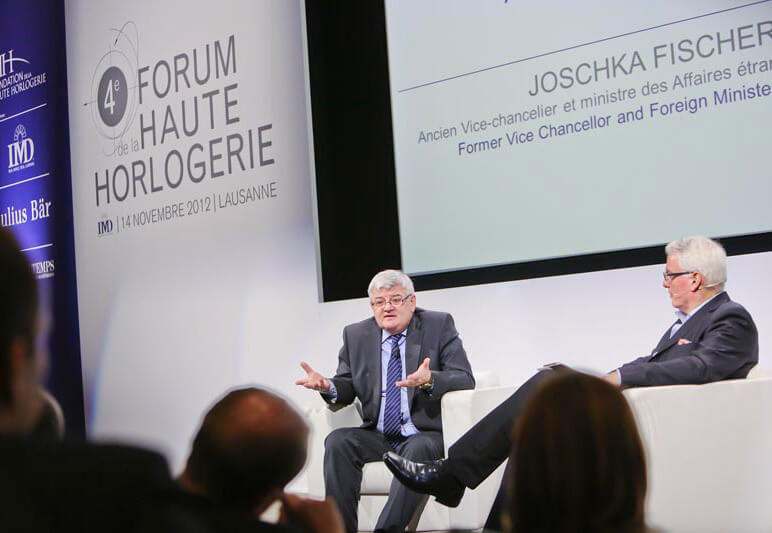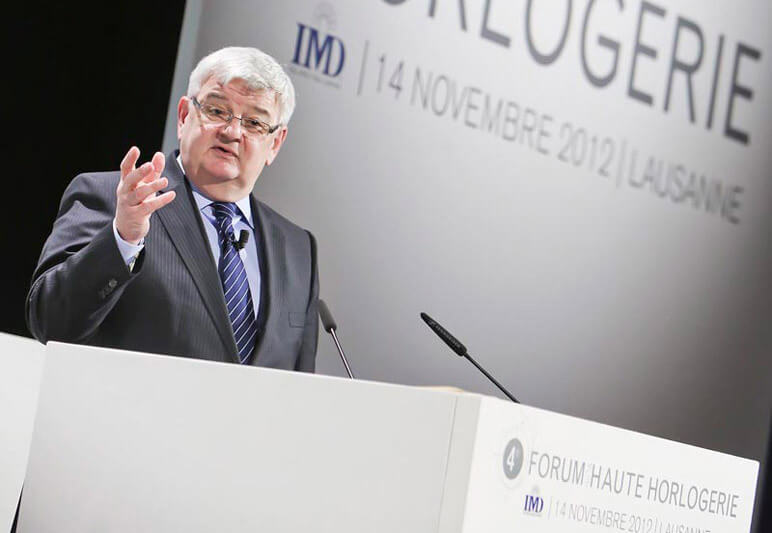What do conditions in Chinese factories have to do with brands’ insatiable appetite for pastures new, corporate social responsibility, and a definition of luxury and beauty? Potentially nothing, or rather the Forum de la Haute Horlogerie, a now annual gathering – this year held on November 14th – organised by the Fondation de la Haute Horlogerie as a platform for high-level debate and exchange for the industry. While these subjects may seem poles apart, they nonetheless converge towards an analysis of current market conditions, and the position luxury goods now have as a global consumption phenomenon.
A form of ecstasy?
In this light, to equate luxury with beauty is doubtless a notion worth dwelling on, in the company of art critic Philippe Daverio. The word “luxury” comes from the Latin luxus, which in turn hints at luxuria, the debauchery and lust which the Church condemned as one of the seven deadly sins, and of which it had first-hand knowledge, particularly during the Renaissance. The Romans at the time of the Republic proscribed any lustful inclinations in the private sphere. Only magnificentia, the great and sublime projects that served to exalt Latin genius, found grace in their eyes. Thus senators wore a toga with a purple border to symbolise the virtue of austere moral conduct. Similarly, the Romans had no precise concept of beauty other than pulchritudo which, as Philippe Daverio reminded the audience, has connotations of grace more than beauty.
Such imprecision was not exclusive to Rome. The Greeks, torn between Plato and Aristotle, between the intelligible world and metaphysical understanding, could not imagine beauty other than as a corollary of goodness and therefore verity; the famous καλὸς κἀγαθός whose use is attested since Herodotus. For Philippe Daverio, it’s a short step to concluding that beauty in itself exists only as a pure product of society. As proof he cites the female beauties painted by Botticelli and Rubens, some tall and slender, the others verging on a state of chronic cellulite. What place does horology have in a contemporary context, where luxury and beauty correspond to a form of ecstasy, as suggested in these verses by Charles Baudelaire: “There, there is but beauty, measure, luxury, repose and pleasure” (“Invitation to the Voyage”, The Flowers of Evil, 1857). Without rehashing the whys and wherefores of watchmaking’s genesis in Geneva, Daverio put forward his theory that timekeeping was predestined to develop there, supported by an elegance inherited from French culture. Thus it gave rise to objects which literally “tell time”, the ancestors of today’s watch as a symbol of the cyclical nature of time, and which fascinates not for its beauty – as ultimately beauty does not exist – but for its primary function as a reminder that luxury is also a question of temporality.
Huge opportunities for growth
Staying with temporality, many brands seem to live in the moment, obsessed as they are with putting their logo on an ever-expanding array of products. According to Dominique Turpin, president of IMD, the prestigious business school in Lausanne which hosted the Forum, this makes sense but under certain conditions. Some examples of brand extension are so successful to have become textbook cases. Think of General Electric which moved smoothly from aviation to financial services; Montblanc, a specialist in writing instruments and now also a watchmaker, or Caterpillar which made its name in bulldozers and now sells shoes. At the other end of the spectrum, McDonald’s never made it big in pizza, Bic’s disposable underwear flopped, Heinz never cut the mustard, and Xerox failed in computers.
What management may consider to be a logical diversification doesn't necessarily add up for the customer.
These unsuccessful endeavours confirm Turpin’s view that there is no point stretching a brand to segments that are only slightly distinct from its core business, particularly if perceived value falls short of customers’ expectations. “
What management may consider to be a logical diversification doesn’t necessarily add up for the customer,” he explained. “Customers don’t buy a strategy. They want something that will cure their ‘headaches’ to put it bluntly.” What, then, are the keys to the kind of success enjoyed by Yamaha, whose reputation is well-established in segments as diverse as motorbikes, keyboards and audio equipment? According to Turpin, diversification must bring meaningful value to the customer and must benefit from the brand’s ‘aura’. “Basically, the three conditions are to propose innovative ideas in terms of technology and/or design; be consistent with the brand, particularly with respect to communication; and bring something genuinely new to the market. If these three factors are in place, then brand stretching, while not the be all and end all, offers huge opportunities for growth, and could even be the price a brand must pay for eternal youth.”
Creating shared value
Nestlé for one is no stranger to diversification. In his keynote speech, Peter Brabeck-Letmathe, Chairman of the Board of Nestlé SA, discussed how one of the major challenges facing today’s multinationals is to maintain growth, and at the same time have a positive impact on society and the environment. “Not so long ago, companies cared almost exclusively about how much shareholder value they could create, and had little time to worry about their responsibility towards the wider community,” he observed. “They then tried to clear their conscience through donations, like philanthropists. At Nestlé, we believe growth can only be conceived as something which creates value for shareholders and society. This is what we call ‘creating shared value’. Questions that were at the bottom of the corporate agenda a few years ago are now important issues that we must resolve.”
Nestlé initiated the process in 2006, first through compliance with laws, business principles and codes of conduct that impose the highest standards. The result is a form of sustainable development that meets the needs of the present but won’t leave future generations to foot the bill. Backed by its growing business, Nestlé has implemented programmes in the three areas of nutrition, water, and rural development. These initiatives run alongside the group’s business activities, all seen as steps forward to a better world. Others have since followed suit as many multinationals have woken up to these values, and are adopting an approach that is the essential and natural corollary of any economic growth.
Mention economic growth and all eyes turn to China, recently promoted to the world’s second largest economy. The country has become a driving force for the luxury industry in the widest sense. But what are working conditions in the factories that produce many of the goods western consumers buy? Over the past few years, numerous observers have spoken out against the oppressive production methods which have seen China grow into the world’s factory. Not so, says the journalist Leslie T. Chang, whose book, Factory Girls, documents the daily lives of young Chinese women employed in these factories. “Chinese workers are not forced into factories because of our insatiable desire for iPods. They choose to leave their farming villages for the city in order to earn money, to learn new skills, to improve themselves, and to see the world. And they are forever changed by the experience. In the latest debate over factory conditions, what’s been missing is the voices of the workers.”
As Leslie T. Chang observes, these women barely mention their living conditions, which most Americans would see as only a step up from prison life, rarely speak about the products they manufacture, and often have difficulty explaining what they do. What matters to them is what they personally gain or how, through work, they met a best friend or a boyfriend. It would be meaningless to calculate how long a worker would have to labour to buy the item she is helping produce, like an iPhone, she concludes. “Across China, there are 150 million migrant workers, a third of them women, who have left their villages to work in the factories, restaurants, hotels, and construction sites of the cities. They represent the largest migration in human history; their experiences have changed the way they work and marry and live and think. Very few of them would want to return to the way things used to be. Should we feel bad when we buy ‘Made in China’? I don’t think so. But whether you do or not is peripheral to a much larger and more important story.”















